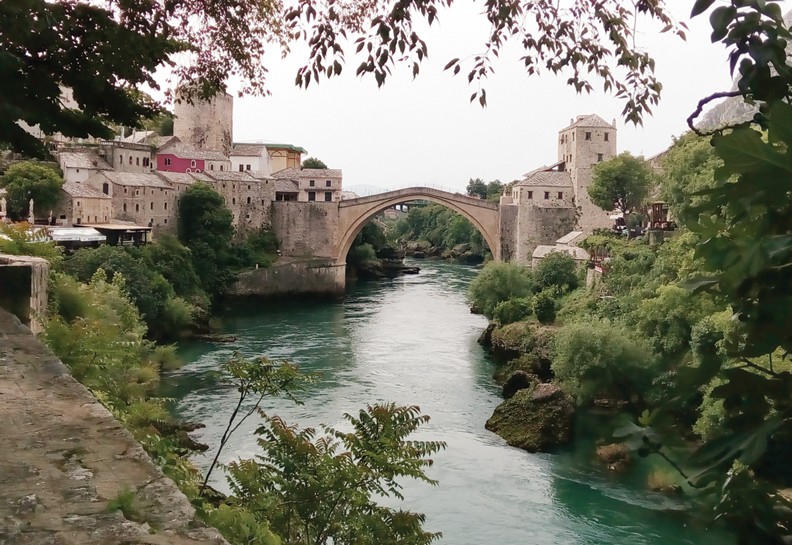
The historic city of Mostar where Muslims, Croats and Serbs are still learning to deal with an uneasy political environment

Arriving at Sarajevo International Airport brought back the memory of the saga of the Bosnian President Ali Ezzat Begovic’s detention at the airport by Serb forces on his return from Lisbon at the height of the Bosnian war. Expecting UN protection on his arrival, Begovic was shocked to discover that the UN van deputed to take him from the airport had left without waiting for him. This neglect delivered him right into the hands of the Serbian forces. Later on, he was exchanged for one of the Serb generals in possession of the Bosnian forces.
Sarajevo International Airport, not modified much since the incident, is busy as well as spick and span. My first port of call in the country was the historic city of Mostar. I was most fortunate to have my friend Nikolina Obradovic, as my host and guide. Her husband, Tibor, came to pick me from the airport. The drive from Sarajevo to Mostar was breathtakingly beautiful. As our car zigzagged through mountains and lakes, Tibor showed me the mountain resort where Marshal Tito used to entertain his foreign guests. This Sarajevo-Mostar road journey is just as breathtaking as it is to drive through Switzerland.
Although the road is used more, the railway line still runs parallel to the road and close to the top of the mountains. There are small hamlets and villages on the roadside, with mosques’ minarets visible, signifying the Muslim population. Hotels have sprung up along the route as well since tourists accessing the famous Dalmatian Coast use the road.
Mostar is the fifth largest city of Bosnia and Herzegovina. Like Sarajevo, Mostar was another important theatre during the war, experiencing fierce fighting between Serb, Croat and Muslim forces. The worst-ever clashes were between Muslim and Croat forces.
Almost 20 years after the war, the city still bears the scars of that protracted conflict. Most buildings are still riddled with bullet marks. Some historical ones are still being rebuilt to replicate the originals. In the eastern part, you find vibrant signs and symbols of Muslim cultural and religious life in the form of Turkish cultural centres and Islamic centres.
The city is nestled between two hills. Like most Bosnian towns, the two parts of this city are joined through various bridges. The highlight of the city and an important landmark is the Old Bridge. The original bridge became an unfortunate casualty of the war and had to be rebuilt in recent years in the same mould. Most tourists tend to congregate around the bridge area which is a charming and attractive sight.
Like Sarajevo, Mostar is also divided into two halves by a river. The western part of Mostar has the Lenin Street as its main thoroughfare with parks and other government buildings dotting along. Signs of division, despite political union, are all there for you to see. While in the past there was only one university, now there are two: one Croat-dominated and the other Muslim-dominated.
I asked the manager of my hotel, a Muslim how he felt about the future. He did not sound that optimistic. When I asked him about the local media and its reporting, he told me there was no such thing as objective news in Mostar or Bosnia. Each news had three news versions: a Muslim, a Croat and a Serb version. Even the announcement of death, he added, was colour-coded: while deaths of members of other communities are black and red-bannered, news of a Muslim’s death is shown in green.
The Boulevard of Mostar where a gymnasium or school is also located is an informal dividing line between the East and the West. Like elsewhere in Bosnia, there are three schools within one: one for Bosnian Muslims, one for Croats, and one for Serbs. This division, as in the news, runs throughout the school system in the Bosnian-Muslim-Croat federation, noticeably in Sarajevo in particular.
In the western part of Mostar, signs of affluence are more visible. Yet, despite these long-running and deepening divisions, people are in the process of learning the art of living together and trying to tackle uneasy political arrangements that govern them. The dominant feeling of things not yet quite settling lingers on somehow, at the moment.
My hunch is that while Tito kept the ethnic and identity politics under wraps by anchoring the nation in the concept of unity and brotherhood, Muslims in the post-communist era find themselves adrift. The war in Bosnia itself caught them unprepared and exposed them to the rude shock of ethnic politics. It is possible that the identity crisis might get accentuated in the coming years until a very strong and visionary leadership emerges to solidify the Muslim identity within the multicultural world of the Balkans.
However, Turkish and Arab influence is outpacing this slow-going process of delicate and balanced negotiations. But, relapsing into yet another war is not a viable option any more. "One simple reason for this is that not many people would be willing to take up violence as a way of settling territorial and political issues," my friend Nikolina told me.
Besides, most young people are leaving the town in droves due to lack of employment opportunities.
While walking through Mostar, I came, quite unexpectedly, upon the statue of the great writer of the region, Ivo Andric, a Noble Prize winner for literature.
Mostar’s own charm, the beautiful landscape, and the love and laughter of friends there, makes the city an ideal place for a re-visit.